Close to home: Allison Vitsky Sallmon and Andy Sallmon
Close to Home
Text: Allison Vitsky Sallmon, D.V.M.
Images: Andy Sallmon and Allison Vitsky Sallmon
My story begins at 4 am on an August morning in 2013. I was hastily checking local diving updates before we packed the car for our private charter, and the news wasn’t good. Over the past few days, a plankton bloom had played havoc with the visibility, changing the water from tropical blue to mud-puddle brown. Apparently, we had awakened at this obscenely early hour to dive during the worst conditions of the summer.
There are no refunds for bad visibility in Southern California, so we did what we sometimes have to do in order to pursue blue water: We asked the captain to head offshore until we found it. This type of diving can be frustrating, but it will occasionally yield incredible pelagic subject matter, and it seemed like the best option on that day.
Hours later, things were still looking grim. We’d been motoring all morning and had found nothing interesting to photograph. At long last, we spotted a tangle of loose kelp on the surface, and next to it was a telltale flash of white fin. “Mola!” yelled the captain, and we geared up and slipped into the water, cameras in hand. We approached the bizarre fish slowly, but it headed for depth as soon as it saw us. I sighed and prepared to signal the boat, freezing when I heard a deafening exhalation nearby. I turned in disbelief to see a huge, curved back coming directly towards me.
The blow had come from a blue whale, a creature that very few people have seen under the water. These may be the largest animals to have ever lived on the earth, but they are endangered and incredibly shy. I took a breath and dove down to get a look at it, reflexively pointing the camera and depressing the shutter. As I did, the whale rolled his body up and looked at me. I met his gaze, trying to memorize the moment as the behemoth disappeared below me.
We saw nothing else that day, but it hardly mattered. Anything else would have been wasted on me anyways. I sat on the deck, dazed, until it was time to unload our gear. I dreamed about that whale for weeks, and I wish my tale ended here.
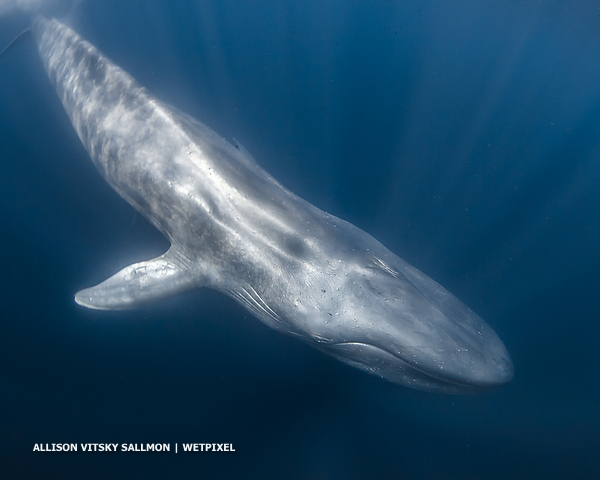
A year later, we were on a charter boat again, this time aiming towards some offshore reefs. When we saw a blow in the distance, we stopped the motor and pulled out our topside cameras. We heard the whine of an outboard approaching, and a small rigid hulled inflatable boat (RHIB) carrying a captain and a single photographer pulled up nearby.
We watched in awe as a massive blue whale surfaced again and again. The ocean had taken on a pungent smell, and we began to see krill hopping along the surface of the water. We heard another blow behind us and then saw more blows a few hundred feet to our left. Within minutes, 25-meter-long whales were visible in every direction, feeding on the thick krill.
Two whales began surfacing in unison, and I photographed them until I realized I could no longer keep the RHIB out of the frame. The stern of the RHIB lifted abruptly, and as I disbelievingly lowered my camera for a split second, one of the whales surfaced and then descended over the stern of the small inflatable, capsizing it. The two whales, indifferent to the presence of the boat, began lunge feeding around the inflatable, their pectoral fins thrust skywards. The captain was flailing next to the RHIB, and after a few long moments, the passenger reached up and grasped the side of the capsized boat. The whales made two more leisurely passes next to the overturned inflatable before they dove, at which point we were able to pull the captain and her passenger aboard our larger craft. They nervously awaited evacuation, the shocked silence punctuated only by occasional awkward laments by the captain about her crippled boat and the photographer about his flooded camera. We were 14 kilometers offshore; although not much was said about it at the time, it escaped no one that had another boat not been in the immediate area, the outcome of this incident could have been very different.
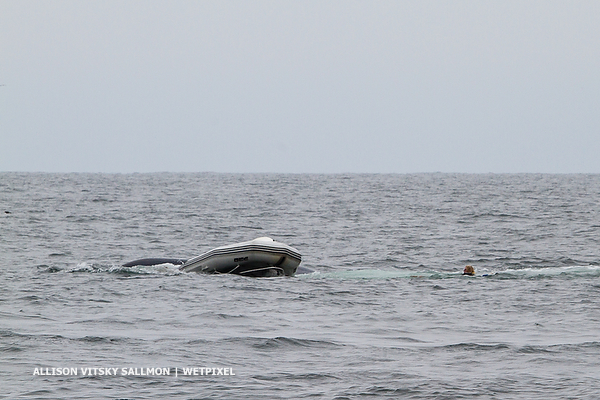
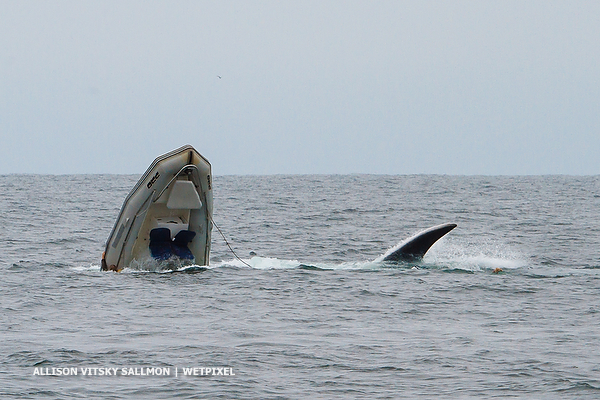
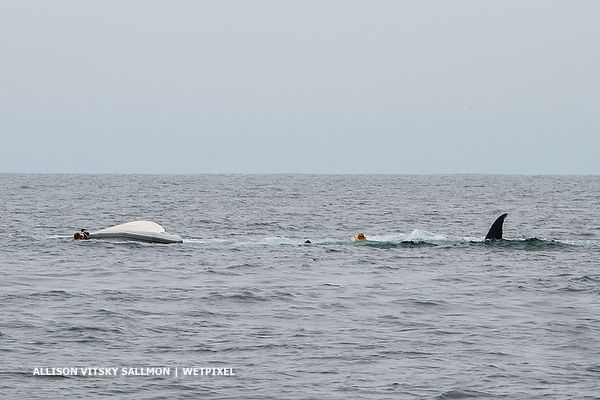
We went on with what remained of our dive day, but by the time we returned to the harbor, we’d received phone messages from both the US Coast Guard and NOAA, requesting statements for their investigations. That wasn’t unexpected, but it was just the beginning. Within 24 hours, the story had been picked up by the news media, and several outlets aired tense interviews with the photographer about his terrifying brush with death. Completing the sensationalist sequence of events, an associated Go Pro video promptly went viral.
Although this was undoubtedly a frightening event for the RHIB captain and passenger, I was overcome by a deep sense of frustration. It seemed that almost everyone had missed the larger point. The whales were not in our homes, lurking next to our dinner. We were in theirs.
I began dreaming about blue whales again, about unimaginably huge animals that have adapted to feed on unimaginably tiny animals, a punishing oxymoron that obligates the largest animal on the planet to forage almost constantly. And feed it does, across thousands of miles and through some of the most trafficked shipping lanes in the ocean. Even if the krill are not in shallow water, there remains the unfortunate fact that the whales must surface occasionally to breathe. The overall result is a Russian roulette-like scenario that sometimes brings horrific consequences.
2007, the year I moved to Southern California, was a particularly deadly year for these creatures. At least four blue whales were killed by ship strike/assumed ship strike between Ensenada, Mexico and San Miguel Island, California alone. According to the Channel Islands Cetacean Research Unit, the events of 2007 occurred due to an unusual temporary density of krill within the Southern California shipping lanes. This series of deaths was the impetus for a shift of California’s shipping lanes in 2012, but discussion on additional change has begun again following scientific recommendations to alter shipping lanes further.
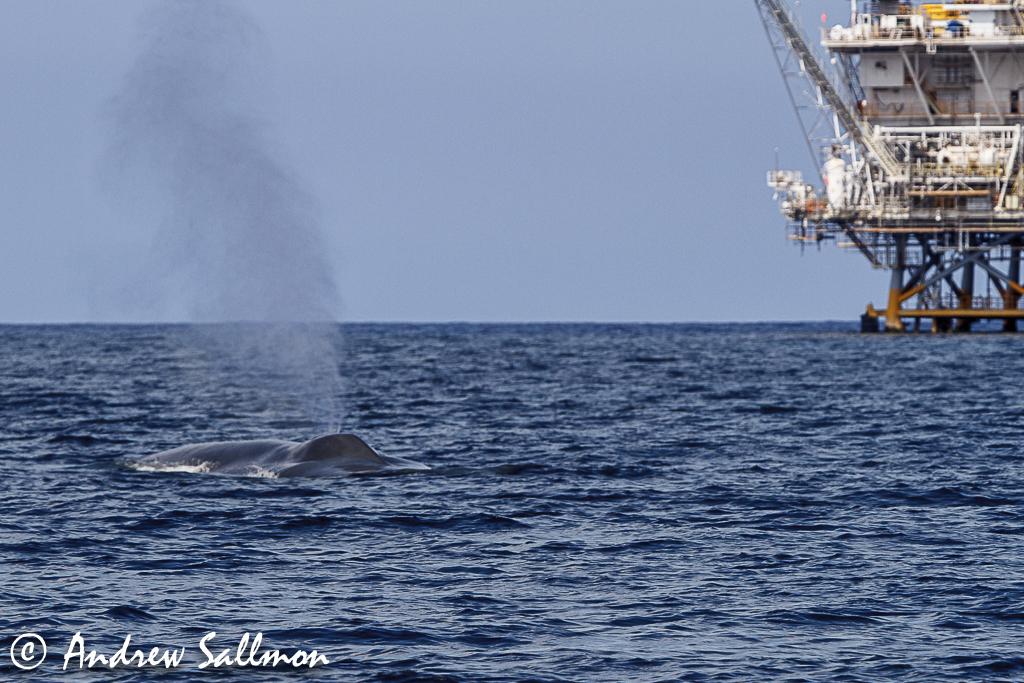
Similar issues affecting large baleen whales are not well known to the public. Perhaps this is a matter of “out of sight, out of mind” more than anything else. An internet search for baleen whale images brings up almost exclusively images of humpbacks, a gregarious smaller species that can be reliably viewed by traveling to their mating and calving grounds during particular times of year. Blue whales are bashful and far less predictable; seeing them from a whale watching boat typically provides most viewers only fleeting glimpses of an unspectacular hump with a tiny dorsal fin. Lunge feeding behavior is a special event, and breaching is practically unheard of. Few people have been able to view blue whales in the water, and because of their large size relative to typical water clarity, even fewer people have managed to capture full-body images.
Trends in photography may also be indirectly working against large baleen whales. In 2013, Iceland resumed hunting endangered fin whales (the blue whale’s runner-up in size), and its traditional 2014 whale hunt was quietly kicked off with the killing of one of these majestic creatures. During the 2014 whaling season alone, 137 fin whales have reportedly been slaughtered by Icelandic whalers. However, the country’s rugged beauty ironically attracts the tourism dollars of thousands of nature photographers each year, and it now seems to have become a fashionable destination for underwater photographers looking to get off the beaten path. What hope is there for endangered baleen whales without the full attention of their most likely allies?
We’ve been out on the ocean many times since we witnessed the collision between blue whale and RHIB, and we’ve seen these beautiful creatures on several more occasions. We’ve seen them feeding adjacent to gill nets, next to the oil platforms off of Los Angeles, and in the middle of crowded recreational fishing areas. I am still dreaming about whales, but my dreams have reverted to those of last year. A huge whale swims slowly towards me, and then rolls up to meet my eye before he dives deeply, far away from the surface of the ocean.
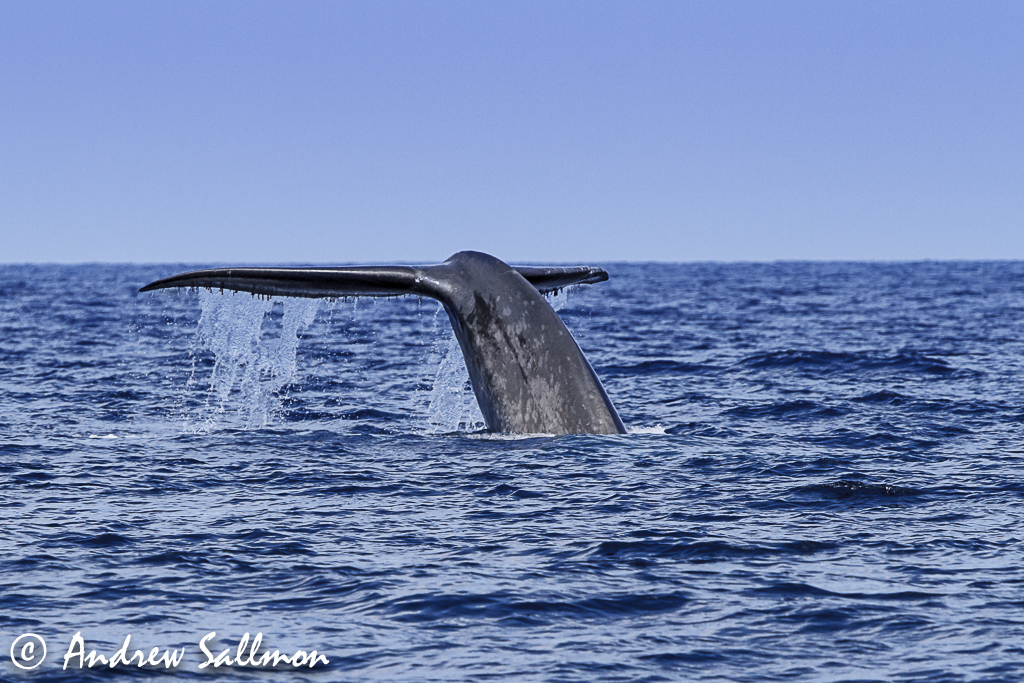
About the authors:
Andy Sallmon and Allison Vitsky Sallmon are a photography/writing team that has been working together since 2010. Andy’s educational background in marine biology and Allison’s in journalism and veterinary medicine provide a unique perspective on our oceans and the life they hold.
Individually, their work has been recognized in numerous international underwater and nature photography competitions, featured on the walls of aquariums and museums, and published in books and magazines on diving, nature, and photography. The two combined have 54 years of recreational and technical diving experience with more than 10,000 dives all over the world. However, their favorite place to dive is the rich, temperate water of their home state: California. Andy and Allison live in San Diego.
Please visit Andy’s and Allison’s websites to see more of their work.